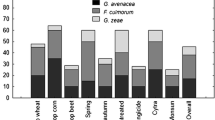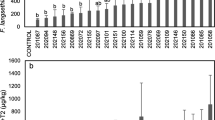Abstract
Aflatoxin assays and moisture determinations were made on locks from bolls inoculated withAspergillus flavus 30–32 days from flower and harvested after additional periods of 5, 7, 9, 11, 13 and 15 days. Inoculated locks were always tight but had moisture contents comparable to those in non-inoculated locks on the same bolls. Lowest toxin concentrations were in seeds from bolls still green at harvest with moisture contents >50%; highest concentrations were in bolls with fully fluffed locks and moisture contents <10%. The greatest increase in toxin concentrations occurred in bolls following suture opening, at the initiation of boll dry-down. Toxin concentrations were comparable for bolls that fluffed in 11 days from inoculation and those requiring 15 days for fluffing. A boll fluffing 11 days from inoculation had the highest level of toxin detected, ca 400 μg/g. The ripening and drying processes rather than the duration of fungal/plant interactionper se seems critical for maximum toxin formation.
Similar content being viewed by others
References
Ashworth LJ Jr, McMeans JL, Brown CM (1969) Infection of cotton byAspergillus flavus. J Stored Prod Res 5:193–202
Ashworth LJ Jr Rice RE McMeans JL Brown CM (1971) The relationship of insects to infection of cotton bolls byAspergillus flavus. Phytopathology 61:488–493
Halloin JM (1982) Localization and changes in catechin and tannins during development and ripening of cottonseed. New Phytol 90:651–657
Klich MA (1987) Plant water potential at the time of anthesis/inoculation as a factor inAspergillus flavus entry into cotton seeds. Phytopathology 77:739–741
Lee LS (1988) Aflatoxin in Arizona cottonseed: Lack of toxin formation followingAspergillus flavus inoculation of sutures. J Amer Oil Chem Soc 65:127–128
Lee LS, Lacey PE, Goynes WR (1987) Aflatoxin in Arizona cottonseed: A model study of insect-vectored entry of cotton bolls byAspergillus flavus. Plant Dis 71:997–1001
Marsh PB, Bollenbacher K, San Antonio JP, Merola GV (1955) Observation on certain fluorescent spots in raw cotton associated with the growth of microorganisms. Text Res J 25:1007–1016
Marsh PB, Simpson ME (1984) Detection ofAspergillus flavus and aflatoxins in cotton and corn by ultraviolet fluorescence. J Environ Qual 13:8–15
Official Methods Recommended Practices of the American Oil Chemist's Society, Third Edition, rev. to 1986. AOCS, Champaign, IL
Author information
Authors and Affiliations
Rights and permissions
About this article
Cite this article
Lee, L.S., Klich, M.A., Cotty, P.J. et al. Aflatoxin in Arizona cottonseed: Increase in toxin formation during field drying of bolls. Arch. Environ. Contam. Toxicol. 18, 416–420 (1989). https://doi.org/10.1007/BF01062367
Received:
Issue Date:
DOI: https://doi.org/10.1007/BF01062367




